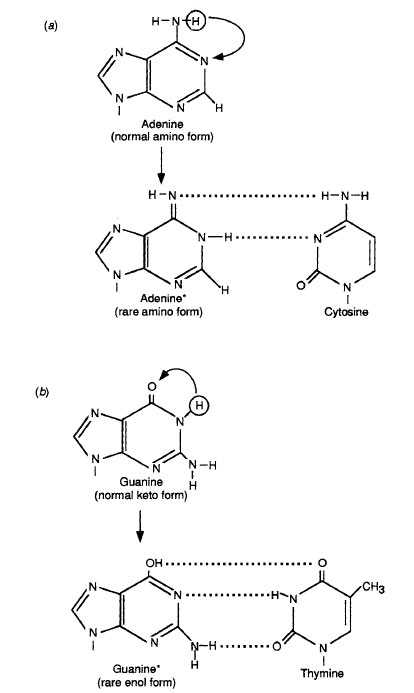Types of Mutations
Mutations are heritable changes in the genetic material that give rise to alternative forms of any gene. These alternate forms are called alleles. There are two broad types of mutations, those that affect the gene and those that affect whole chromosomes (chromosomal aberrations). Gene mutations at the nucleotide level are called point mutations. Any errors in the replication of a gene within the DNA molecule resulting in the insertion, deletion, or substitution of one or more bases will give rise to a mutation. Even though the cell has mechanisms to improve the fidelity of DNA replication, every once in a while a spontaneous mistake is made leading to a heritable change in the DNA sequence. In the laboratory, mutation rates can be greatly increased by exposing cells to chemicals or physical agents called mutagens.Many mutations are due to the instability of the nucleotide bases in the DNA . Nucleotide bases may undergo structural changes called tautomeric shifts (Figure 6-1), which result in the redistribution of electrons and protons so that the bases no longer pair normally. G may pair with T or A with C, resulting in heritable changes in the nucleotide sequence. Transitions occur when the mispairing results in the replacement of one purine for another or one pyrimidine for another. Transversions result when a purine is replaced by a pyrimidine or vice versa. Because the structural changes leading to transitions are relatively small, they occur more frequently than transversions, which require more substantial modifications of a molecule.
 |
| Figure 6-1 Tautomeric shifts and abnormal base pairing. |
Point mutations resulting from base substitutions in a gene that code for a polypeptide may result in missense, nonsense, or silent muations. Missense mutations result in the replacement of one sense codon for another, altering the amino acid encoded in that position. Anonsense mutation creates one of the three stop codons (UGA, UAA, UAG) and results in polypeptides that are shorter than the normal ones. Silent mutations are changes in the sequence of the codon that do not alter the encoded amino acid.
Frameshift mutations are the result of nucleotide or base insertions or deletions within the coding region of a gene. The genetic code is translated by the protein synthesis apparatus by reading sequential groups of three bases that make up a codon, beginning from the start codon. If a single base is added or removed, all of the codons from that point on will be changed. A truncated protein may result if a codon is mutated to one of the three stop codons.
Notes
Sickle cell anemia results from a GAG → GUG transversion within a glutamine codon. The mutant hemoglobin protein has valine in its place, and these cells become crescent shaped under low oxygen tension.




